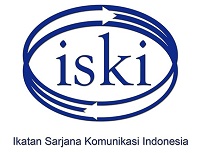- Focus and Scope
- Section Policies
- Peer Review Process
- Publication Frequency
- Open Access Policy
- Publication Ethics
- Reviewer Guidelines
- Letter of Originality
Focus and Scope
Mediator: Jurnal Komunikasi focuses on communication studies and media. Although centered on communication, the Mediator is open and welcomes the contribution of many disciplines and approaches that meet at crossroads with communication studies. The type of writing is in the form of scientific articles based on the results of field research. This journal is intended as a medium of scientific study to communicate vision, reflection, conceptual thinking, research results, exciting experiences in the field, and critical analysis studies on contemporary communication issues.
Section Policies
Articles
Resubmit
Peer Review Process
The practice of peer review is to ensure that good science is published. It is an objective process at the heart of good scholarly publishing and is carried out on all reputable scientific journals. Our referees therefore play a vital role in maintaining the high standards of Composite Structures and all manuscripts are peer reviewed following the procedure outlined below.
Initial manuscript evaluation
The Editor first evaluates all manuscripts. It is rare, but it is entirely feasible for an exceptional manuscript to be accepted at this stage. Those rejected at this stage are insufficiently original, have serious scientific flaws, have poor grammar (English/Bahasa Language), or are outside the aims and scope of the journal. Those that meet the minimum criteria are passed on to at least 2 experts for review.
Authors of manuscripts rejected at this stage will normally be informed within 2 weeks of receipt.
Type of Peer Review
This journal employs double blind reviewing, where both the referee and author remain anonymous throughout the process.
How the referee is selected
Referees are matched to the paper according to their expertise. Mediator: The Journal of Communication has a policy of using double blind refereeing (as detailed in the previous section).
Referee reports
Referees are asked to evaluate whether the manuscript :
- Is original
- Is methodologically sound
- Follows appropriate ethical guidelines
- Has results which are clearly presented and support the conclusions
- Correctly references previous relevant work
Referees are not expected to correct or copyedit manuscripts. Language correction is not part of the peer review process.
How long does the review process take?
The time required for the review process is dependent on the response of the referees. Should the referees’ reports contradict one another or a report is unnecessarily delayed a further expert opinion will be sought. In rare cases for which it is extremely difficult to find a second referee to review the manuscript, or when the one referee’s report has thoroughly convinced the Editor, decisions at this stage to accept, reject or ask the author for a revision are made on the basis of only one referee’s report. Referees may request more than one revision of a manuscript.
Final report
A final decision to accept or reject the manuscript will be sent to the author along with any recommendations made by the referees, and may include verbatim comments by the referees.
Editor’s Decision is final
Referees advise the editor, who is responsible for the final decision to accept or reject the article.
Publication Frequency
Journal Mediator, published two (2) times a year, every June and December.
Open Access Policy
This journal provides immediate open access to its content on the principle that making research freely available to the public supports a greater global exchange of knowledge.
Publication Ethics
ETHICS STATEMENT OF MEDIATOR: JURNAL KOMUNIKASI
Based on COPE’s Best Practice Guidelines for Journal Editors.
- Publication Decisions
- Duties of Reviewers
- Duties of Authors
Publication decisions
The editor is responsible for deciding which of the articles submitted to the journal should be published.
The editor may be guided by the policies of the journal's editorial board and constrained by such legal requirements as shall then be in force regarding libel, copyright infringement and plagiarism. The editor may confer with other editors or reviewers in making this decision.
Fair play
An editor at any time evaluate manuscripts for their intellectual content without regard to race, gender, sexual orientation, religious belief, ethnic origin, citizenship, or political philosophy of the authors.
Confidentiality
The editor and any editorial staff must not disclose any information about a submitted manuscript to anyone other than the corresponding author, reviewers, potential reviewers, other editorial advisers, and the publisher, as appropriate.
Disclosure and conflicts of interest
Unpublished materials disclosed in a submitted manuscript must not be used in an editor's own research without the express written consent of the author.
Duties of Reviewers
Contribution to Editorial Decisions
Peer review assists the editor in making editorial decisions and through the editorial communications with the author may also assist the author in improving the paper.
Promptness
Any selected referee who feels unqualified to review the research reported in a manuscript or knows that its prompt review will be impossible should notify the editor and excuse himself from the review process.
Confidentiality
Any manuscripts received for review must be treated as confidential documents. They must not be shown to or discussed with others except as authorized by the editor.
Standards of Objectivity
Reviews should be conducted objectively. Personal criticism of the author is inappropriate. Referees should express their views clearly with supporting arguments.
Acknowledgement of Sources
Reviewers should identify relevant published work that has not been cited by the authors. Any statement that an observation, derivation, or argument had been previously reported should be accompanied by the relevant citation. A reviewer should also call to the editor's attention any substantial similarity or overlap between the manuscript under consideration and any other published paper of which they have personal knowledge.
Disclosure and Conflict of Interest
Privileged information or ideas obtained through peer review must be kept confidential and not used for personal advantage. Reviewers should not consider manuscripts in which they have conflicts of interest resulting from competitive, collaborative, or other relationships or connections with any of the authors, companies, or institutions connected to the papers.
Duties of Authors
Reporting standards
Authors of reports of original research should present an accurate account of the work performed as well as an objective discussion of its significance. Underlying data should be represented accurately in the paper. A paper should contain sufficient detail and references to permit others to replicate the work. Fraudulent or knowingly inaccurate statements constitute unethical behavior and are unacceptable.
Originality and Plagiarism
The authors should ensure that they have written entirely original works, and if the authors have used the work and/or words of others that this has been appropriately cited or quoted.
Multiple, Redundant or Concurrent Publication
An author should not in general publish manuscripts describing essentially the same research in more than one journal or primary publication. Submitting the same manuscript to more than one journal concurrently constitutes unethical publishing behaviour and is unacceptable.
Acknowledgement of Sources
Proper acknowledgment of the work of others must always be given. Authors should cite publications that have been influential in determining the nature of the reported work.
Authorship of the Paper
Authorship should be limited to those who have made a significant contribution to the conception, design, execution, or interpretation of the reported study. All those who have made significant contributions should be listed as co-authors. Where there are others who have participated in certain substantive aspects of the research project, they should be acknowledged or listed as contributors.
The corresponding author should ensure that all appropriate co-authors and no inappropriate co-authors are included on the paper, and that all co-authors have seen and approved the final version of the paper and have agreed to its submission for publication.
Disclosure and Conflicts of Interest
All authors should disclose in their manuscript any financial or other substantive conflict of interest that might be construed to influence the results or interpretation of their manuscript. All sources of financial support for the project should be disclosed.
Fundamental errors in published works
When an author discovers a significant error or inaccuracy in his/her own published work, it is the author’s obligation to promptly notify the journal editor or publisher and cooperate with the editor to retract or correct the paper.
Reviewer Guidelines
Writing a Review
1. Research the journal
- Visit the journal homepage (on Mediator: Jurnal Komunikasi) to get a sense of the journal’s published content and house style. This will help you in deciding whether the paper being reviewed is suitable for the journal or not.
- Refer to the Instructions for Authors to check if the paper meets the submission criteria of the journal (e.g. length, scope, and presentation).
2. Write your report
Questions to consider
The main factors you should provide advice on as a reviewer are the originality, presentation, relevance, and significance of the manuscript’s subject matter to the readership of the journal.
Questions to have in mind when reading the manuscript (in no particular order):
- Is the submission original?
- Does the paper fit the scope of the journal?
- Would the paper be of interest to the readership of the journal?
- Does the paper help to expand or further research in this subject area?
- Does it significantly build on (the author’s) previous work?
- Do you feel that the significance and potential impact of a paper is high or low?
- Is the paper complete? Is there an abstract or summary of the work undertaken as well as a concluding section?
- Is the methodology presented in the manuscript and any analysis provided both accurate and properly conducted?
- Are all relevant accompanying data, citations, or references given by the author?
- Should it be shortened and reconsidered in another form?
- Would you recommend that the author reconsider the paper for a related or alternative journal?
- Is the submission in Standard Bahasa (or English) to aid the understanding of the reader?
Provide detailed comments
- These should be suitable for transmission to the authors: use the comment to the author as an opportunity to seek clarification on any unclear points and for further elaboration.
- If you have time, make suggestions as to how the author can improve clarity, succinctness, and the overall quality of presentation.
Make a recommendation
Once you’ve read the paper and have assessed its quality, you need to make a recommendation to the editor regarding publication, such are:
- Accept Submission – if the paper is suitable for publication in its current form.
- Revisions Required – if the paper will be ready for publication after light revisions. Please list the revisions you would recommend the author makes.
- Resubmit for Review– if the paper would benefit from substantial changes such as expanded data analysis, widening of the literature review, or rewriting sections of the text.
- Decline Submission – if the paper is not suitable for publication with this journal or if the revisions that would need to be undertaken are too fundamental for the submission to continue being considered in its current form.
Letter of Originality
SURAT PERNYATAAN
HAK CIPTA DAN ORISINALITAS
Saya yang bertanda tangan di bawah ini :
Nama :
NIK :
Institusi :
Nomor HP :
dengan ini menyatakan bahwa judul artikel
(tuliskan judul artikel dalam bahasa Inggris)
benar bebas dari plagiat dan publikasi ganda, dan apabila pernyataan ini terbukti tidak benar maka saya bersedia menerima sanksi sesuai ketentuan yang berlaku.
Dengan publikasi ini, saya mengalihkan hak cipta untuk Mediator: Jurnal Komunikasi. Transfer hak cipta mencakup hak eksklusif untuk mereproduksi dan mendistribusikan artikel, termasuk mencetak ulang. Hal ini juga meliputi hak untuk mengadaptasi artikel yang digunakan bersama dengan sistem komputer termasuk reproduksi atau publikasi dalam bentuk online dan dipasang pada sistem pencarian.
Demikian surat pernyataan ini saya buat untuk dipergunakan sebagaimana mestinya.
(Kota), Tanggal/Bulan/Tahun
Yang membuat pernyataan,
Materai 10000
……………………………………………….
























